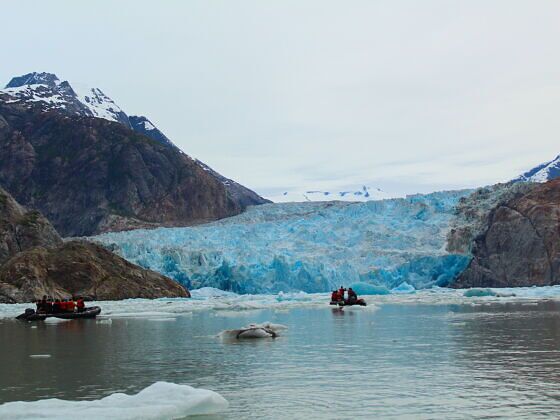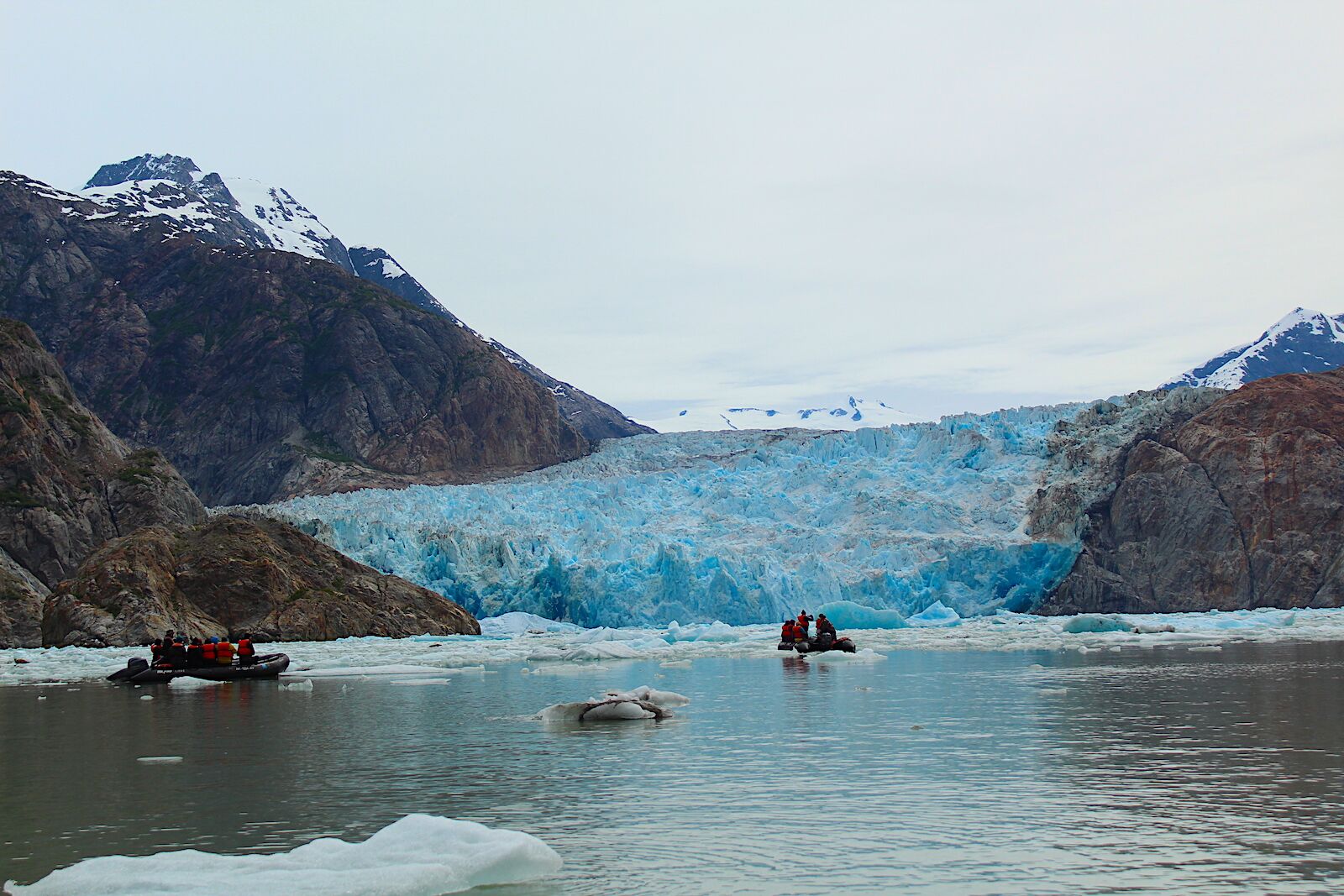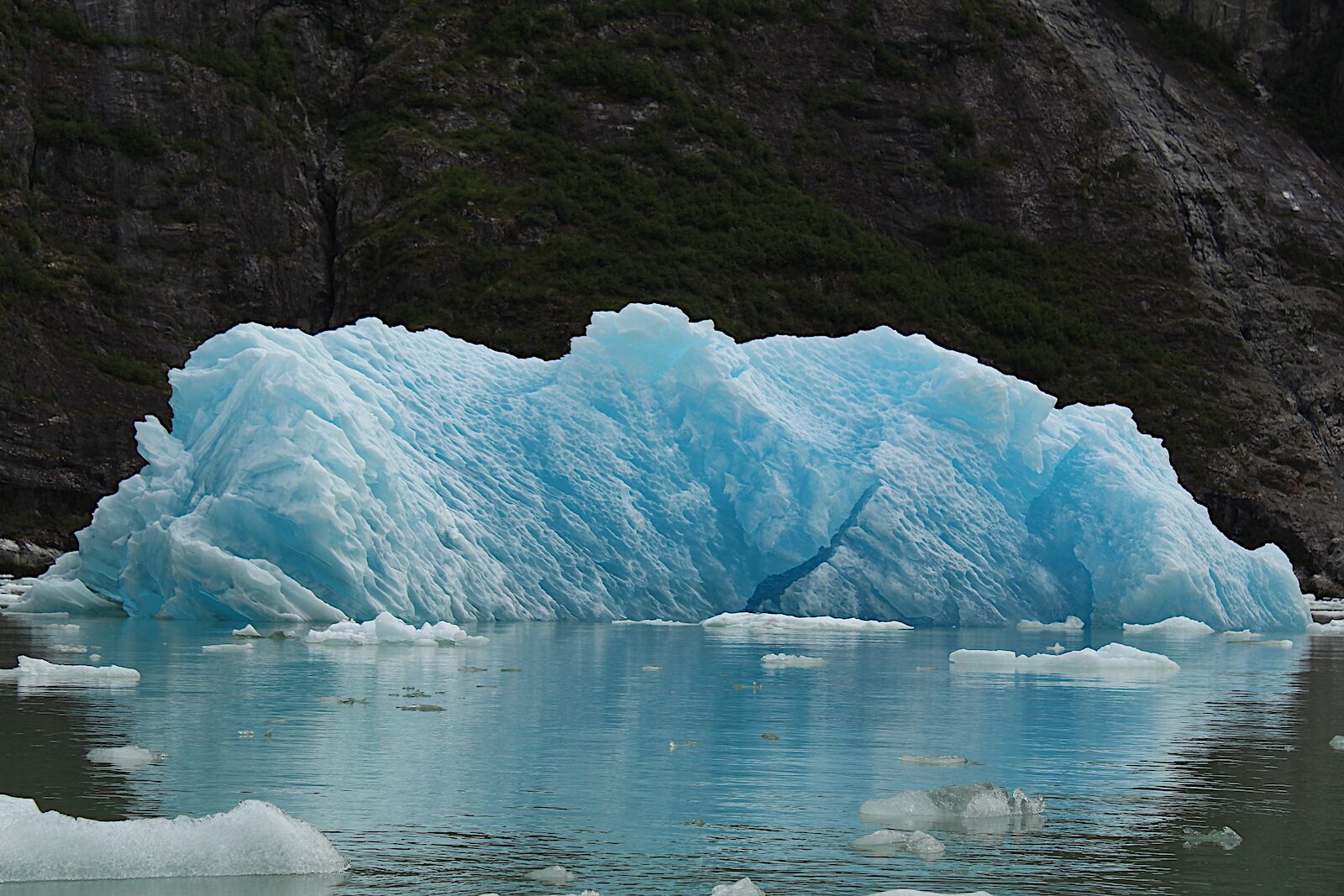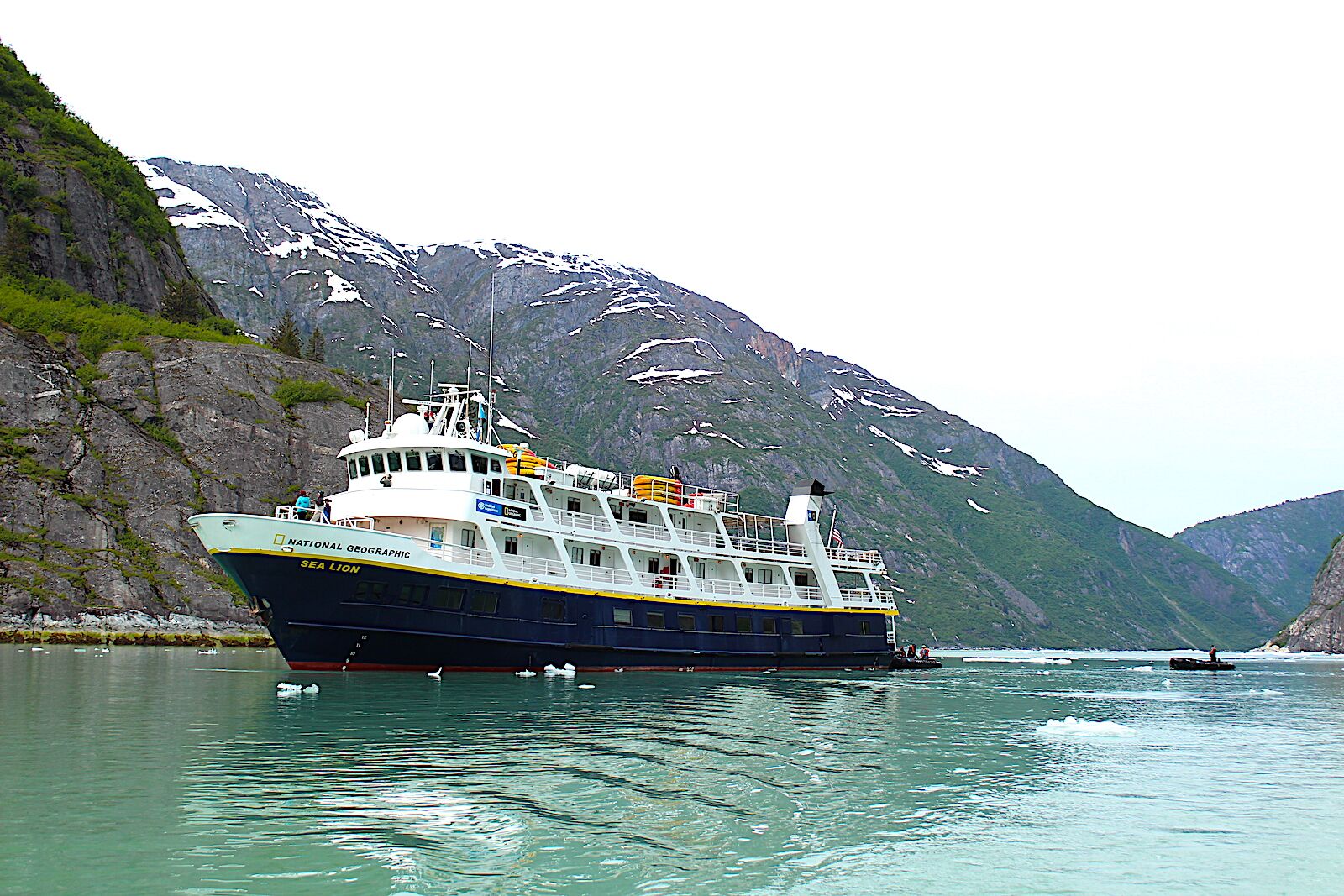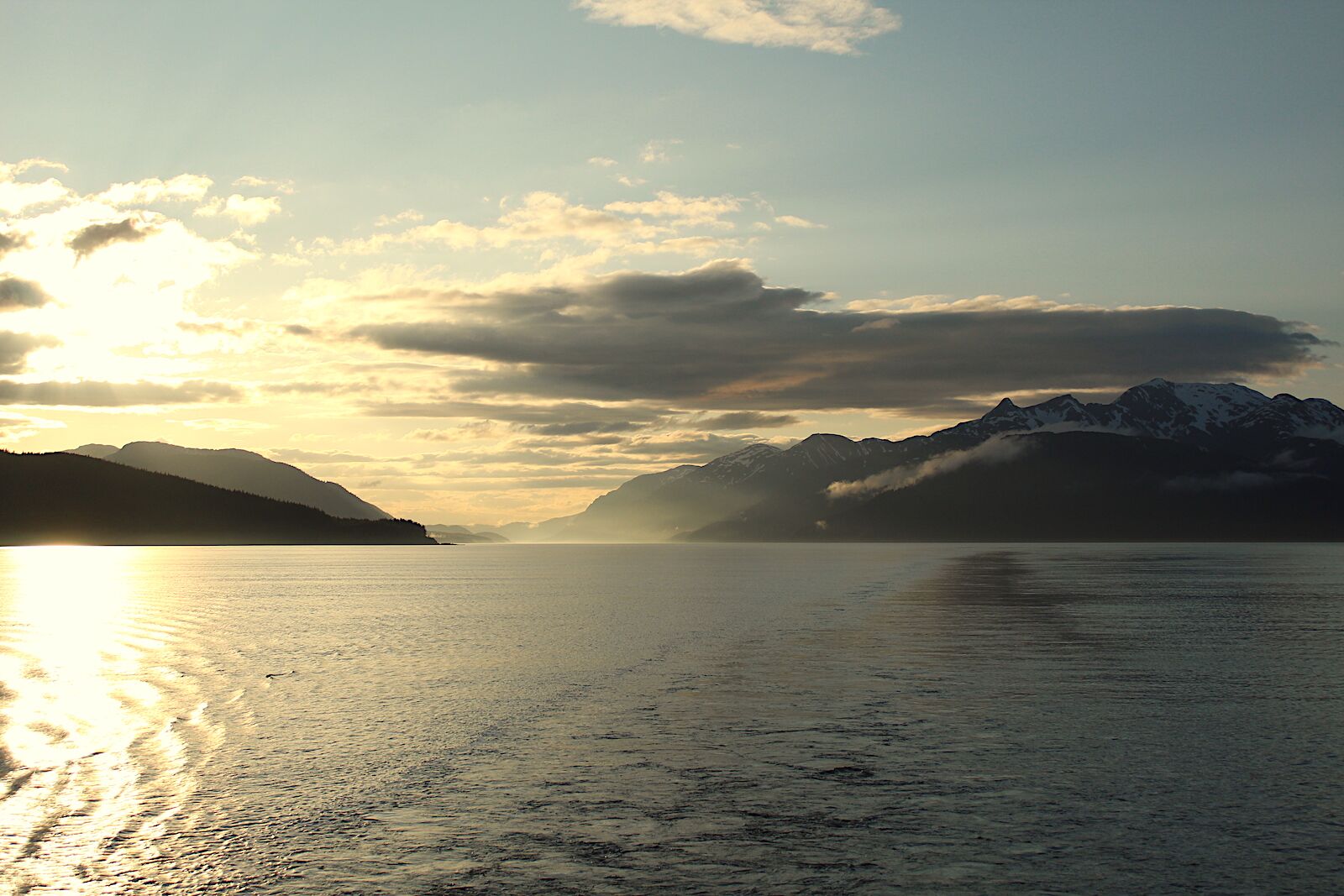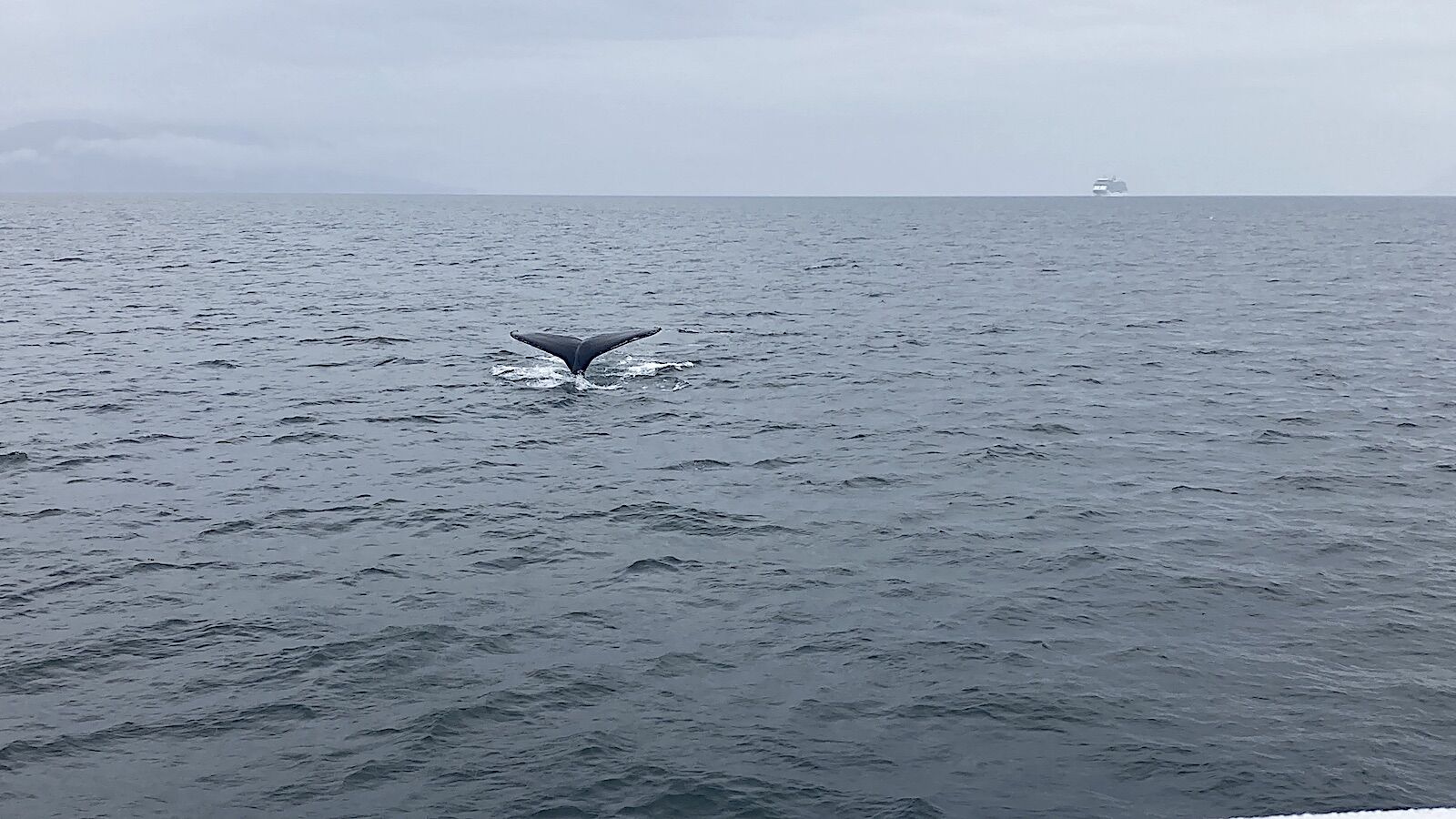A light mid-June rain clouded Alaska’s Stephens Passage in a deep haze. In the distance, the Coast Mountains formed a crescent around the dozen of us gathered on the bow of the National Geographic Sea Lion. This was the second day of Lindblad Expedition’s 6-day Wild Alaska Escape expedition, and humpback whales were breaching around the ship – at least eight, blowing steam that geysered above the water just before they arched their backs into view. Each concluded its show with a triumphant wave of its fluke before descending below the surface. It was as though the whales were showing off, and those of us on the bow collectively cooed at each breaching.
Alaska’s Inner Passage is a wild place, alive in constant evolution. It is the home of the Tlingit and Haida peoples, each known today for elaborate totem poles telling the story of the region and its people. Also calling this area home is the Tsimshian, whose native lands stretch as far east as the Skeena River valley. Here, snowcapped, 2,000-foot peaks rise from the fjords to create barrier islands guarding the arms and passageways of the Alexander Archipelago from the rough-and-tumble Pacific Ocean to the west. When the sun does shine from above, the deep greens of this temperature rainforest contrast with the turquoise inlets and make it obvious why writers from Jack London to Ernestine Hayes have drawn inspiration from this region. Hanging glaciers cling to the sides of these imposing peaks, transforming low into majestic waterfalls that crescendo down vertigo-inducing vertical valleys and then dive into the current in a continual stream of renewal.
This region is shaped by water, something I increasingly understood each morning as a light-but-persistent rain greeted me as I exited my cabin. The only way to properly experience southeast Alaska is to travel upon its water on a boat as nimble as the glaciers themselves. I’d never before ventured west of the Canadian border around here, and embarking on a small-ship cruise expedition with Lindblad Expeditions proved an incredible welcome to The Last Frontier.
Experiencing Tracy Arm Fjord and South Sawyer Glacier
By the time the whales had decided to show off, we’d already spent the bulk of the day in Tracy Arm Fjord, traveling five miles by zodiac to South Sawyer Glacier in search of seals, Bald Eagles, and the impacts of human progress on this fragile landscape. I kept a DSLR and a journal in my waterproof drybag backpack from Remote Design. The crew provided life vests and snacks, including hot chocolate with Bailey’s Irish Cream which proved to be the perfect beverage for glacier viewing. As a Coloradan, I’m accustomed to big mountains but not to living glaciers, at least not those that still actively shape the landscape. South Sawyer Glacier towered above our small rubber boat as we approached, bergy bits – icebergs smaller than five meters – floating around us.
“When I first came here in 2015, that big rock over there was barely exposed,” said Jeff Campbell, our zodiac driver and one of the crew’s naturalists, pointing at a sedimentary rock face just beyond the grasp of the ice, as we approached the glacier. As it stands, the 225-foot calving face rises out of the Tracy Arm Fjord and stretches 24 miles back. As glaciers do, South Sawyer is actively calving into the fjord – those aboard an earlier zodiac boat claimed they witnessed such an event. It receded 1.4 miles between 1985 and 2016, and while much of this is normal, climate change is increasing its demise – the bulk of that recession has happened since 1996. The Tlingit people say the glacier used to advance faster than a dog could run, and that it regularly posed a threat to their villages.
Other glaciers have receded even further. The nearby Grand Pacific Glacier is 64 miles back from where it was when John Muir first came here about 140 years ago, experiencing nearly two miles per year of recession. This rate is, according to Cambridge University Press & Assessment, comparable to what the Cordilleran valleys that stretch across western Canada experienced at the end of the Pleistocene era some 11,000 years ago.
Still, a glacier of such significance remains a sublime, even surreptitious, sight. En route, we saw dozens of harbor seals and half a dozen Bald Eagles. Mountain goats wearing creamy white fur roam the crags and pitches above, remaining out of sight unless heads turn quickly at the sound of trundling rock. While posted up near the glacier, we scanned the surrounding ridges and spotted a pack of about 15 crossing underneath a small snowfield high above us.
Exploring Wrangell and jet boating the Stikine River
We now traveled south, 15 hours of daylight behind us and vibes as high as the surrounding peaks after witnessing at least four species that call this region home. We awoke the next morning docked outside Wrangell, a town of 2,000 located at the northern tip of Wrangell Island and the mouth of the Stikine River. The town is what I’d always imagined an Alaskan fishing village to be: small and walkable, with an unassuming character chiseled by the Alaskan winds and the ebb and flow of the Zimovia Straight tides. Following a Tlingit performance at Chief Shakes Tribal House, I rented an eBike from Breakaway Adventures and cruised the town for a couple of hours, parking only for a quick hike up Mt. Dewey to take in views over the town, water, and surrounding mountains.
In the afternoon our group chartered a jet boat tour with Alaska Charters and Adventures and headed up the Stikine River to Shakes Lake (Chief Shakes, a common colloquialism around here, represents Tlingit tribal leadership and is a name passed down through generations). Here, calved glacier ice floats on top of the turquoise water, reflecting the bright snowcapped peaks of the Coast Range that mark the border with British Columbia a mere five miles away.
The Tongass National Forest Wilderness Area surrounds the Stikine River. The longest such forest in the United States at more than 17 million acres and spanning more than 500 miles from north to south, it is the size of Tennessee and runs 20 percent of the United States’ total coastline. All five species of salmon run this river (that’s chinook, sockeye, coho, chum, and pink, for your curious mind), along with three species of trout. Because the Stikine is undammed and its flow is entirely unaltered by human intervention, it’s among the most vivid examples of pristine waterways in North America. The jet boat ride was bumpy — at times the water is as shallow as six inches deep – but that’s ok – the riverbanks are lined with bald eagle nests for distraction.
An active expedition for the mind, body, and planet
The Wild Alaska Escape expedition, like other Lindblad-run trips, offers ample opportunity to get outside and be active. Throughout the journey, we hiked the terminal moraine – a rocky channel left after a glacier recedes – of the Baird Glacier. Glaciers act as nature’s sandpaper as it scrapes the rocks below it across the ground, shaping the landscape as it moves, and this hike was the closest I’ve come to a scramble near sea level.
We also kayaked in Cascade Creek and hiked a couple of miles up into the coastal temperate rainforest that blankets this region. Emily Mall, a Lindblad naturalist with a background in zoology and ecology, interpreted the trail’s botany. In Misty Fjords National Monument, we kayaked Rudyard Bay, embarked on a wildlife- and glacier-seeking zodiac tour through Owl Pass, and those of us willing to bare the cold partook in a polar plunge.
“In building an itinerary, our goal is to give people that ‘wow’ feeling,” said Oren Frey, our Expedition Leader. “We want them to make the connection between what they’re seeing and an understanding of what they can do to protect it, even if they live far away. Hopefully, we can educate and inspire.
There is perhaps no better way to gain this understanding than this to partake in Citizen Science. Using apps such as Merlin, Clean Swell, and Seek, the naturalists guided us through how to report on findings including plastic pollution and wildlife spotting. Our group reported whale fluke photos to an app called Happy Whale, which tracks individual whales to increase awareness of their range and habitats so that they can be better protected. Using this data, scientists can tell how the whale is doing based on its movements and even identify its sex.
Through the Lindblad Expeditions-National Geographic Fund (LEX-NG), a portion of each traveler’s fare supports conservation initiatives. In southeast Alaska specifically, the foundation funds grants in support of the Alaska Whale Foundation. Globally, the LEX-NG fund supports broad conservation initiatives including grand for the National Geographic Society, National Geographic Pristine Seas, and the Governor Teacher Fellowship. Onboard, guests are encouraged to donate directly to fund if they wish.
Learning from Lindblad naturalists
Even with all this activity, the standout feature of the expedition is the Lindblad staff. What unites them despite their diverse backgrounds is that each has chosen their current path after a life-changing experience in nature. They’re here because they care deeply about the ecology of this region and the greater ocean ecosystem. Each night over happy hour in the ship’s lounge, the naturalists give presentations on topics ranging from the science of glacier retreat to best practices for smartphone photography, typically incorporating what we saw and did that day into the talk (which, coincidentally, often involved plankton — I failed to realize prior to this expedition that this microscopic organism is responsible for 50 percent of the world’s oxygen, and that it absorbs carbon to create this oxygen much as trees do). At one point, the entire cabin joined together in a celebratory song about the three types of rocks (igneous, sedimentary, and metamorphic). The staff engages to the point of becoming like family in a few short days, also joining guests during meals and over morning coffee and evening documentary screenings in the lounge.
Campbell even gave a presentation on how to identify sustainable seafood, whether hunted, ranched, or farmed, and what to avoid. Throughout each talk, we learned a series of simple but startling facts about conservation, marine ecology, and sustainability that can be applied to daily life. For example, trawling for seafood – scraping the bottom of the sea – is horrible for biodiversity and the planet, as only about 10 percent of what is caught is the target fish. The other 90 percent is bycatch. This is why avoiding trawled seafood, like most shrimp, is preferable for a more sustainable marine environment.
With its turquoise seawater rippling through glacier-carved fjords, few locations on Earth provide a more visceral image of our planet’s living ecosystem than Alaska’s Inner Passage. It would be impossible to venture through here without gaining a better understanding of the interconnectedness of matter both alive and inanimate. The impact of this excursion resonated, for me, far more deeply than striking visuals.
You, too, should visit the Inner Passage for its beauty and for the adventures it holds. You should visit to dispel any lingering doubt that there’s a better way forward for humanity than one of conquest and consumption. And to create memories with loved ones and instill in your kids an appreciation for the natural world. As a carbon-neutral tour operator, Lindblad Expeditions offsets the emissions of each trip. If you leave here indifferent to the impact that we as humans are having on places like this, then there truly is no hope for humanity.
